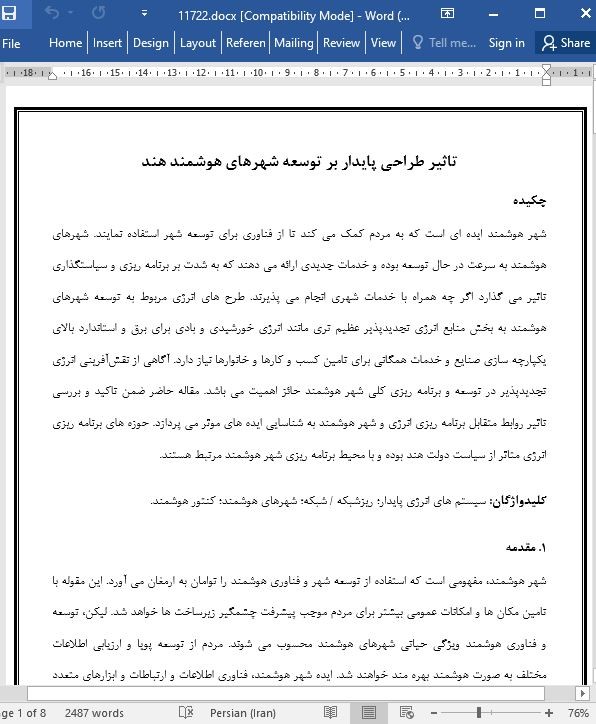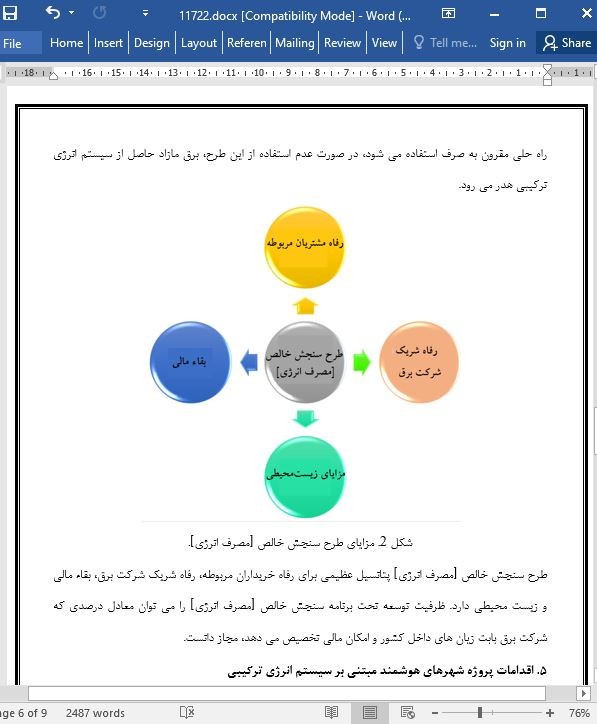
تاثیر طراحی پایدار بر توسعه شهرهای هوشمند هند
چکیده
شهر هوشمند ایده ای است که به مردم کمک می کند تا از فناوری برای توسعه شهر استفاده نمایند. شهرهای هوشمند به سرعت در حال توسعه بوده و خدمات جدیدی ارائه می دهند که به شدت بر برنامه ریزی و سیاستگذاری تاثیر می گذارد اگر چه همراه با خدمات شهری انجام می پذیرند. طرح های انرژی مربوط به توسعه شهرهای هوشمند به بخش منابع انرژی تجدیدپذیر عظیم تری مانند انرژی خورشیدی و بادی برای برق و استاندارد بالای یکپارچه سازی صنایع و خدمات همگانی برای تامین کسب و کارها و خانوارها نیاز دارد. آگاهی از نقشآفرینی انرژی تجدیدپذیر در توسعه و برنامه ریزی کلی شهر هوشمند حائز اهمیت می باشد. مقاله حاضر ضمن تاکید و بررسی تاثیر روابط متقابل برنامه ریزی انرژی و شهر هوشمند به شناسایی ایده های موثر می پردازد. حوزه های برنامه ریزی انرژی متاثر از سیاست دولت هند بوده و با محیط برنامه ریزی شهر هوشمند مرتبط هستند.
۶. نتیجه گیری
مقاله حاضر بر جنبه های مختلف توسعه شهری پایدار با سیستم انرژی ترکیبی تاکید می نماید. شهرهای هوشمند به سرعت در حال ظهور بوده و خدمات جدیدی ارائه می دهند که به شدت بر برنامه ریزی و سیاستگذاری تاثیر می گذارد. سیستم انرژی ترکیبی با رویکرد سنجش خالص [مصرف انرژی] در شبکه اصلی ادغام شده و طرح سنجش هوشمند به دارنده این سیستم اجازه می دهد تا برق اضافی حاصل از سیستم انرژی ترکیبی را به شکت برق با قیمتی دقیق که برق از شبکه اصلی تامین می شود، بفروشد و این امر منجر به صرفه جویی اقتصادی می گردد. در این کار، سیستم انرژی خورشیدی و بادی برای برق و استاندارد بالای یکپارچه سازی صنایع و خدمات همگانی برای تامین کسب و کار و خانوارها در نظر گرفته شد. به علاوه، امکان سنجی اقتصادی سیستم انرژی ترکیبی متصل به شبکه برای بهره برداری اقتصادی و کارآمد این سیستم برای تامین برق ساختمان های مسکونی، تجاری و صنعتی در شهر هوشمند در هند ارائه گردید. همچنین، اقدامات پروژه شهر هوشمند مبتنی بر سیستم انرژی ترکیبی مورد بحث قرار گرفته است.
Abstract
Smart city is an idea that helps people to use technology for the development of city. Smart cities are developing fast and they present new services which extremely influences planning and policy making, although they take place with urban services. Energy schemes for smart cities development need the higher part of renewable energy sources i.e. solar and wind for electricity and high standard of integration of utilities and industry providing business and households. It is more important to know the renewable energy contribution in the overall smart city’s development and planning. This paper highlights and measures the impact of energy planning and smart city interrelation and recognizes the meeting ideas. The energy planning scopes are drawn from the Indian government policy and they are related with smart city’s planning environment.
6. Conclusion
This paper highlights the different aspects of sustainable urban development with hybrid energy system. Smart cities are emerging fast and they provide the new services which tremendously effect the planning and policy making. The hybrid energy system is integrated to the main grid with the smart metering approach and the net metering scheme permits the owner of the system to sell the extra power generated from the hybrid energy system to the utility at the exact price at which the electricity is brought from the main grid, this would give the economic saving. In this work, solar and wind energy system for electricity and high standard of integration of utilities and industry providing business and households is considered. Further, the economic feasibility of grid-connected hybrid energy system for economical and efficient operation of the system to electrify the different residential, commercial and industrial buildings in smart city in India is presented. Also, hybrid energy system based smart city project actions are discussed.
چکیده
۱. مقدمه
۲. توسعه شهرهای هوشمند مبتنی بر سیستم انرژی ترکیبی
۳. اقتصاد تجزیه و تحلیل سیستم انرژی ترکیبی
۴. رویکرد سنجش خالص [مصرف انرژی] برای شهرهای هوشمند
۵. اقدامات پروژه شهرهای هوشمند مبتنی بر سیستم انرژی ترکیبی
۶. نتیجه گیری
Abstract
1. Introduction
2. Development of the hybrid energy system based smart cities
3. Economics of hybrid energy system- analysis
4. Net metering approach for smart cities
5. Hybrid energy system based smart cities project actions
6. Conclusion
References
- اصل مقاله انگلیسی با فرمت ورد (word) با قابلیت ویرایش
- ترجمه فارسی مقاله با فرمت ورد (word) با قابلیت ویرایش، بدون آرم سایت ای ترجمه
- ترجمه فارسی مقاله با فرمت pdf، بدون آرم سایت ای ترجمه



